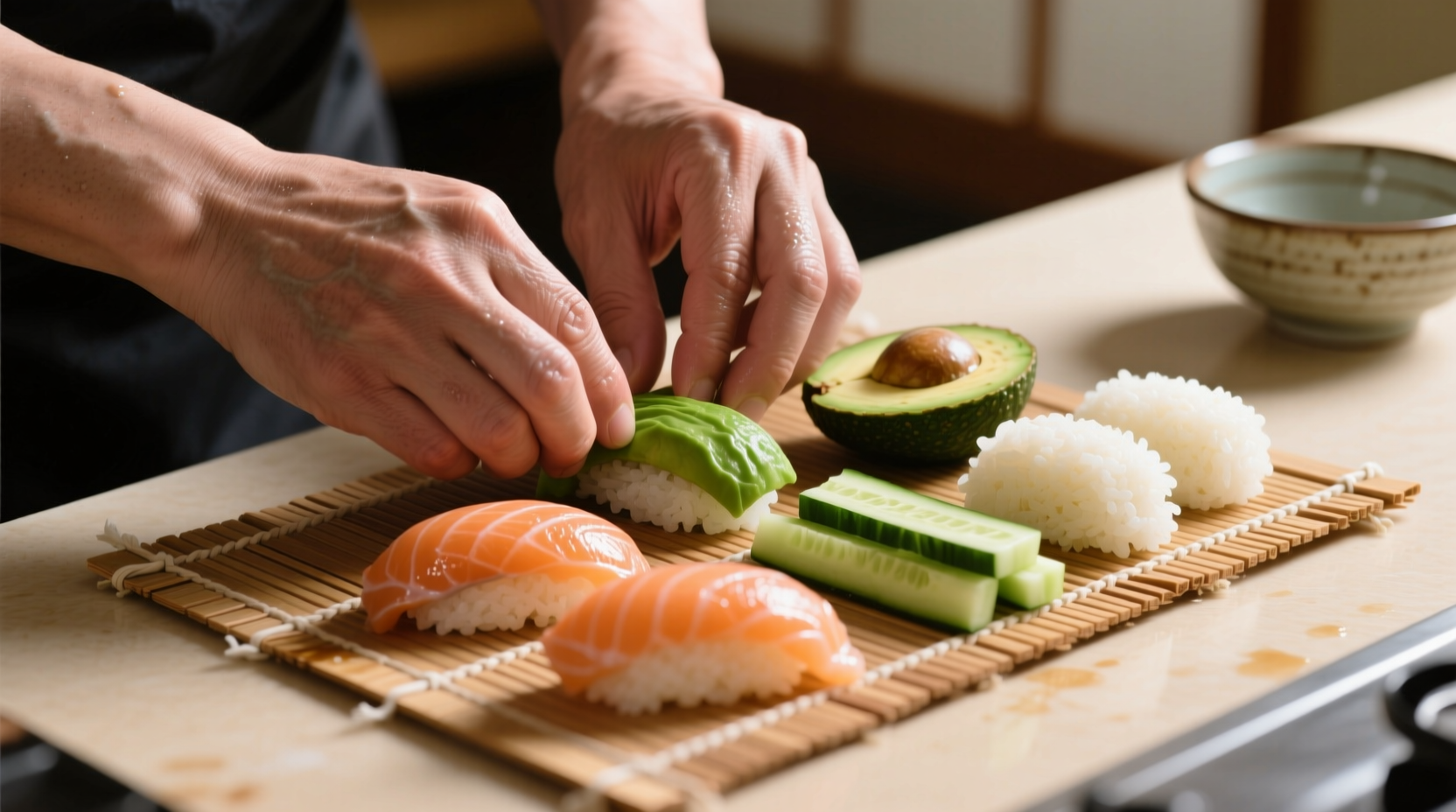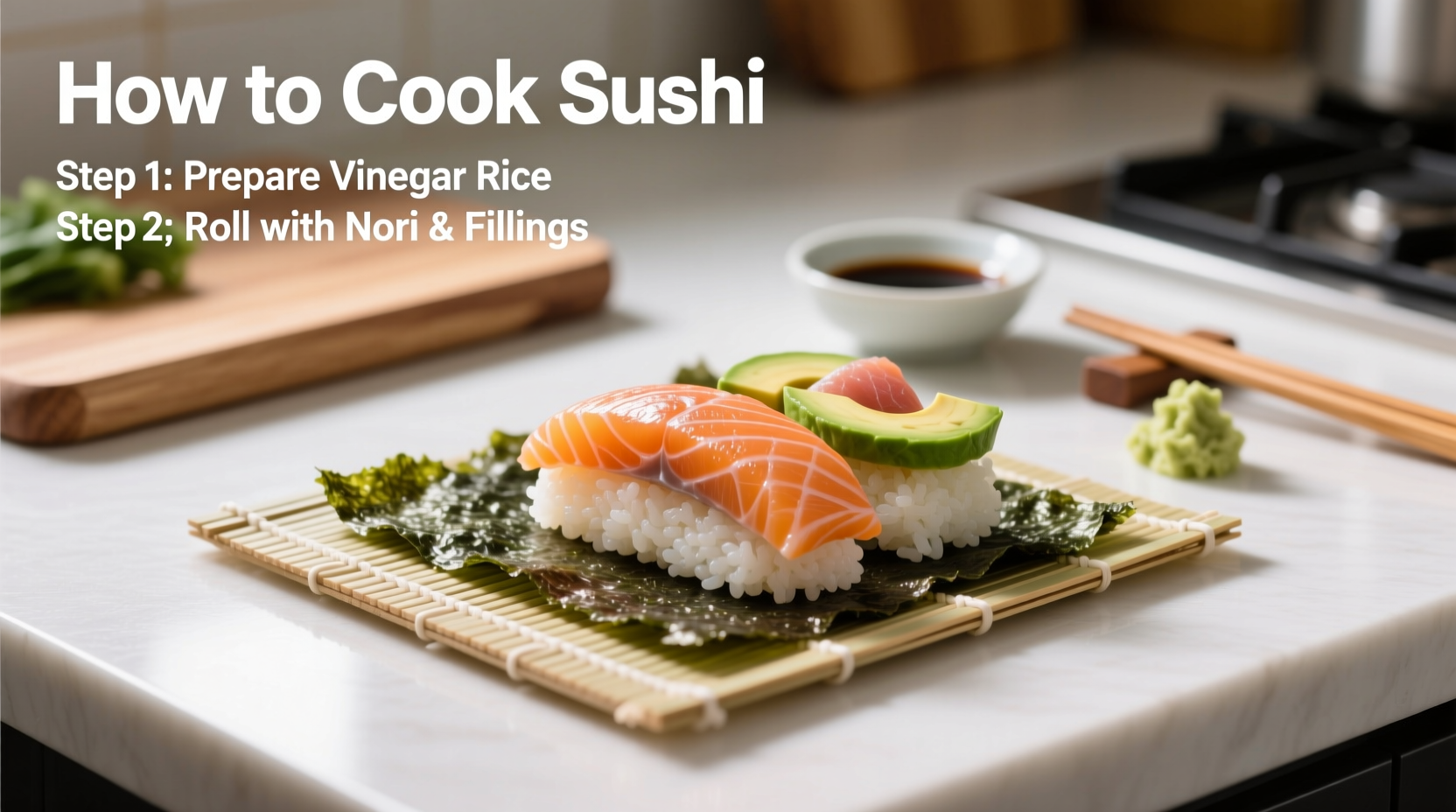Essential Tools and Ingredients for Home Sushi Making
Creating restaurant-quality sushi at home starts with the right equipment and fresh ingredients. You don't need professional-grade tools, but certain basics are non-negotiable for success.
Must-Have Sushi Equipment
- Hangiri (wooden rice tub) - Traditional cypress container that absorbs excess moisture while cooling rice
- Shamoji (rice paddle) - Flat wooden paddle prevents crushing delicate rice grains
- Sharp yanagiba knife - Single-beveled blade ensures clean cuts without damaging fish
- Makisu (bamboo mat) - Essential for consistent rolling pressure (wrap in plastic for hygiene)

Ingredient Selection Guide
Quality ingredients make or break your sushi. Follow these professional standards:
| Ingredient | Professional Standard | Home Cook Alternative | Avoid |
|---|---|---|---|
| Rice | Koshihikari short-grain | "Sushi rice" labeled varieties | Medium/long grain rice |
| Fish | Sashimi-grade, previously frozen at -4°F | Trusted fishmonger's "sushi-grade" | Regular grocery store fish |
| Vinegar | Unseasoned rice vinegar | Organic rice vinegar | Vinegar with additives |
The Science of Perfect Sushi Rice
Sushi rice constitutes 70% of your roll's texture and flavor. The Japanese call this shari - properly prepared rice that holds shape without being sticky.
Step-by-Step Rice Preparation
- Rinse thoroughly - Wash rice 4-5 times until water runs clear (removes excess starch)
- Soak - 30 minutes minimum for proper water absorption (critical step many beginners skip)
- Cook - 18 minutes simmer, then 10 minutes steam (use rice cooker for consistency)
- Mix vinegar - Combine 50g rice vinegar, 40g sugar, 10g salt per 500g cooked rice
- Fan while mixing - Cool to 92°F while gently folding to achieve glossy finish
Professional sushi chefs measure rice temperature with infrared thermometers. At 92°F, rice properly absorbs vinegar mixture without becoming mushy. Higher temperatures cause excess moisture release, while cooler rice won't absorb seasoning properly.
Fish Safety and Preparation Techniques
Food safety is paramount when working with raw fish. The FDA requires sushi-grade fish to be frozen at -4°F for 7 days or -31°F for 15 hours to eliminate parasites. Never use regular grocery store fish unless explicitly labeled "sushi-grade" or "sashimi-grade".
Proper Fish Handling Protocol
- Thaw frozen fish in refrigerator over 24 hours
- Bring to room temperature 30 minutes before cutting
- Use separate cutting board exclusively for fish
- Sanitize knife between cuts with vinegar solution
When selecting fish, look for firm texture, bright color, and ocean-fresh smell (never fishy). Salmon should have distinct marbling, tuna should show deep red color without brown spots. According to the National Oceanic and Atmospheric Administration's seafood guidelines, proper handling reduces foodborne illness risk by 83%.
Mastering Sushi Rolling Techniques
Different rolls require specific techniques. Practice these fundamental methods before attempting complex creations.
Hosomaki (Thin Rolls) Technique
- Place nori shiny-side down on bamboo mat
- Spread 80g rice in ¼-inch layer covering bottom ⅔ of nori
- Add single filling ingredient along bottom edge
- Lift mat edge and roll forward with firm, even pressure
- Squeeze gently to compact roll before cutting
Uramaki (Inside-Out Rolls) Pro Tips
- Moisten hands with vinegar water to prevent sticking
- Spread rice to cover entire nori sheet
- Flip nori so rice faces down on mat
- Add fillings to center nori strip
- Roll tightly using mat edge as guide
- Roll finished cylinder in sesame seeds or roe
Roll tension is critical - too loose and fillings fall out, too tight and rice squeezes out. Professional chefs apply 3-5 pounds of pressure during rolling. Test your tension by gently pressing roll; it should indent slightly then spring back.
Cutting and Presentation Secrets
How you cut and present sushi dramatically impacts the eating experience. Follow these professional standards:
Knife Skills for Perfect Slices
- Use single-stroke cutting motion (no sawing)
- Wipe blade with damp cloth between cuts
- Angle knife at 20 degrees for clean separation
- Cut rolls in half first, then quarters
- Use 6-8 inch blade for standard rolls
According to culinary research from the Culinary Institute of America, properly cut sushi maintains structural integrity while providing optimal mouthfeel. The ideal slice thickness is ¾ inch - thick enough to hold shape but thin enough for balanced flavor in each bite.
Sushi Evolution Timeline
Understanding sushi's historical context improves your appreciation and technique:
| Era | Development | Modern Application |
|---|---|---|
| 2nd Century CE | Narezushi (fermented fish preservation) | Foundation of rice-acid preservation |
| Edo Period (1603-1868) | Hayazushi (quick-fermented sushi) | Early version of modern sushi rice |
| 1820s | Nigiri created by Hanaya Yohei | Hand-pressed sushi technique still used |
| Post-WWII | Refrigeration enables wider distribution | Modern sushi availability worldwide |
Troubleshooting Common Sushi Problems
Even experienced home chefs encounter these issues. Here's how to fix them:
Rice Problems and Solutions
- Too sticky - Rice overcooked or insufficient rinsing (rinse more thoroughly next time)
- Too dry - Not enough moisture during cooking (add 1-2 tbsp water next batch)
- Not holding shape - Rice too warm when rolling (cool to proper temperature)
Rolling Mistakes to Avoid
- Overfilling rolls (use 15-20g filling per roll)
- Inconsistent pressure during rolling (practice with cucumber first)
- Using wet nori (store nori with desiccant packets)
Food science research from Tokyo University shows that optimal rice texture occurs when amylopectin and amylose starches reach specific gelatinization points. This explains why precise temperature control matters more than many home cooks realize.
When to Modify Traditional Techniques
While tradition matters, certain adaptations make sense for home kitchens:
- For beginners: Use plastic wrap on bamboo mats to prevent sticking
- For Western palates: Add avocado for creaminess (not traditional but widely accepted)
- For safety: Cook fish for vulnerable populations (pregnant women, elderly)
- For convenience: Use pre-made sushi vinegar (check for no additives)
These context-specific modifications maintain authenticity while addressing practical constraints. The key is understanding why traditions exist before modifying them.











 浙公网安备
33010002000092号
浙公网安备
33010002000092号 浙B2-20120091-4
浙B2-20120091-4